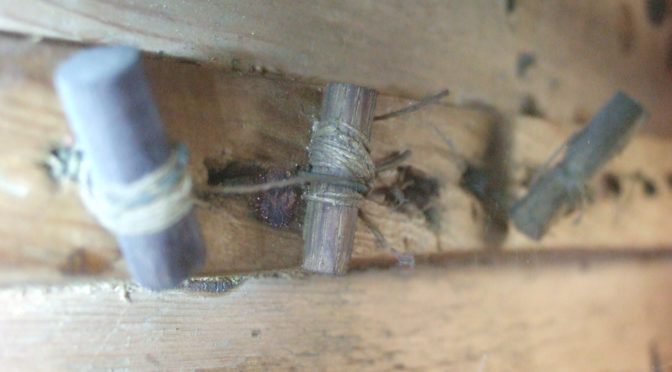The word ursnaidhm (and variants) appears in Bunting’s 1840 book, where it is also translated “The wooden pegs to which the strings are fastened”. Today I was restringing my Student Downhill harp with only four gauges of wire, and I thought I would experiment with the toggle windings, following the historical evidence.
Karen Loomis discussed this a bit in her thesis (volume 1 p.39-42). The toggle knot extracted from one of the string holes on the Lamont harp has a tight wind, as if it were made on a 1.5mm metal toggle. The string goes down, winds round the toggle one-and-a-half times and then a long end about 1cm long is left.
Karen mentions how most people today use the knot described by Ann Heymann in her book Secrets of the Gaelic harp (1988). I remember trying to do simpler knots, but finding that if you coiled the end of the wire tightly around the standing end, the string tension would tend to uncoil it. I think that leaving a long straight end is an interesting way to potentially resist such uncoiling. But on its own it still isn’t enough; you need something to stop it unrolling itself.
Karen also mentions the Sirr harp, though she notes that the date of these strings and toggles is unknown. On the Sirr harp, the string goes down, round the toggle once, and then loops back on itself once. The long straight end doesn’t press the soundboard, but curls partly round the toggle. I think this would nonetheless help resist unwinding.
On the Malahide 1 harp, there are a number of toggles inside the soundbox stuck in the string holes. There are some different winds; one clearly has the string going round the toggle twice. One has a coil of wire around the standing end of the string. A couple clearly show the wire twisted under itself, a little like the traditional method for knotting gut harp strings. All of these toggles also have thread wound tightly around and over the wire winding on the toggle.

Karen Loomis spotted a toggle suspended inside the Hollybrook harp. It has the wire going once round the toggle but no turn back or twist is visible. I have not seen inside the back of this harp. I don’t know how old these strings are.
In the Rose Mooney harp, the strings go once round the toggle but no turn or twist is visible. I don’t know how old these strings are.
I would like to see the toggles inside the V&A harp, as I suspect these strings are old.
When I was restringing my HHSI Student Downhill harp today, I started with the Malahide style, with a twist. But in the end I took a leap of faith and did some with the Sirr style single turn. And they hold fine. So I will update my instruction sheet for toggle winding at once!
I was finding that the highest strings (0.48mm) needed the Malahide style twist to stop them unwinding. But from the octave above na comhluige, down to the bass, the Sirr style single turn holds well.
I did try the Lamont winding, but it won’t hold against string tension – it just unwinds. And I tried a wooden toggle the same, without the turn back around the standing end. The lack of a turn means the string comes off the toggle at a tangent, not radially, and so the whole thing just kind of unrolls. So I wonder now what the Lamont wire fragment represents?

As well as Bunting’s translations, we can collate other mentions of toggles and toggle knots in our sources:
…chordæ bacillis inter minora testitudinis foramina e regione posita nodo illigata… (the strings, which are fastened below to toggles inside the belly of the harp, under the line of small holes) grandioribus in trunco foraminibus et utroque chordam laterae, ad excipiendam emittendamque auram, ac bacillos quibus chordæ innectuntur, extrahendos patentibus (At both sides of the strings there are larger holes in the soundbox of the harp, to receive and emit air, and also to allow the toggles to which the strings are fastened, to be changed) (Gratianus Lucius, Cambrensis Eversus, 1662)
…Brass loops in the Belly through which the strings pass … fastened on the inside by a Noose drawn over a bit of wood… (James Talbot’s manuscript, c.1690)
…les chordes …de fil d’archal… sont arrestées par un bout au dedans du ventre de la harpe… (the strings…of brass wire… are held by a nub inside the belly of the harp) (Pierre Trichet, Traité des Instruments de Musique, c.1640)
…the belly of the harp, through which the strings passed, being fixed by transverse pegs of wood… (Letter from James MacDonnell to Edward Bunting, c. 1839)
Talbot’s “Noose drawn over a bit of wood” reminds me of the Malahide one I am using for thin strings, with the tail twisted under the winding.
Good thoughts on toggles and winding; I find myself using a variety of methods, that roughly correspond with whether the degree of stress required for the wire, the gauge, the alloy and toggle material and style; moreover I suspect that methods differed over time. I prefer more than a ‘nub’ in that I think it best if the tension on the toggle is spread laterally, so as not to create a possible fracture line. Of course, this is just my sense of things—and I’ve not run the idea past engineers.